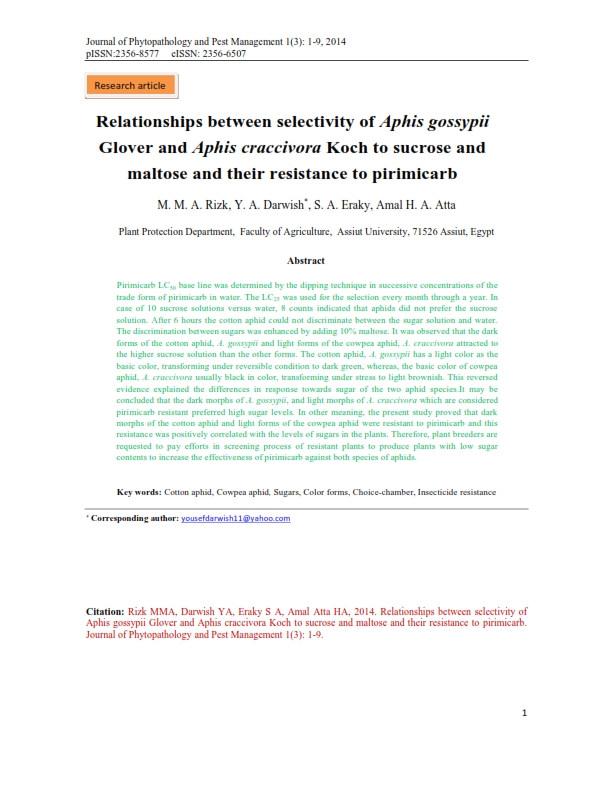Relationships between selectivity of Aphis gossypii Glover and Aphis craccivora Koch to sucrose and maltose and their resistance to pirimicarb
Keywords:
The cotton aphid, The cowpea aphid, sugars, color forms, choice-chamber, insecticide resistanceAbstract
Pirimicarb LC50 base line was determined by the dipping technique in successive concentrations of the trade form of pirimicarb in water. The LC25 was used for the selection every month through a year. In case of 10 sucrose solutions versus water, 8 counts indicated that aphids did not prefer the sucrose solution. After 6 hours the cotton aphid could not discriminate between the sugar solution and water. The discrimination between sugars was enhanced by adding 10% maltose. It was observed that the dark forms of the cotton aphid, A. gossypii and light forms of the cowpea aphid, A. craccivora attracted to the higher sucrose solution than the other forms. The cotton aphid, A. gossypii has a light color as the basic color, transforming under reversible condition to dark green, whereas, the basic color of cowpea aphid, A. craccivora usually black in color, transforming under stress to light brownish. This reversed evidence explained the differences in response towards sugar of the two aphid species.It may be concluded that the dark morphs of A. gossypii, and light morphs of A. craccivora which are considered pirimicarb resistant preferred high sugar levels. In other meaning, the present study proved that dark morphs of the cotton aphid and light forms of the cowpea aphid were resistant to pirimicarb and this resistance was positively correlated with the levels of sugars in the plants. Therefore, plant breeders are requested to pay efforts in screening process of resistant plants to produce plants with low sugar contents to increase the effectiveness of pirimicarb against both species of aphids. Â
Metrics

Downloads
Published
How to Cite
Issue
Section
License
Authors who publish with Journal of Phytopathology and Disease Management agree to the following terms:
- Authors retain copyright and grant the journal right of first publication with the work simultaneously licensed under a Creative Commons Attribution License that allows others to share the work with an acknowledgement of the work's authorship and initial publication in this journal.
- Authors retain copyright and grant the journal right of first publication with the work simultaneously licensed under the Creative Commons Attribution-Non Commercial License (CC BY-NC). This allows others to share the work with an acknowledgement of the work's authorship and initial publication in this journal.
- Archives of Agricultural Sciences Journal is an Open Access Journal, and articles published are distributed under the terms of the Creative Commons Attribution-Non Commercial License (CC BY-NC). Readers may copy, distribute, and display the work for non commercial purposes with the proper citation of the original work. However, the journal retains the right to exploit subsidiary rights on behalf of the authors.
- Authors are able to enter into separate, additional contractural arrangements for the non-exclusive distribution of the journal's published version of the work (e.g. post it to an institutional repository or publish it in a book), with an acknowledgement of its initial publication in this journal.
- Authors are permitted and encouraged to post their work online (e.g., in institutional repositories or on their website) prior to and during the submission process with full disclosure to the journal, as it can lead to productive exchanges, as well as earlier and greater citation of published work. Following publication in Archives of Agricultural Sciences Journal, the author should update the repository, and include a citation and link to the published work.
Click here for more information on Licensing policy
.png)




